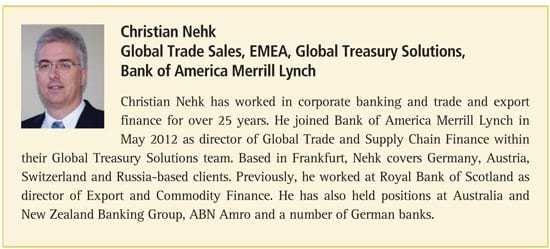by Christian Nehk, Global Trade Sales, EMEA, Global Treasury Solutions, Bank of America Merrill Lynch
Throughout the ages, wherever there has been trade, there has been some form of trade financing. Historians and academics have suggested that mechanisms for the financing of accounts receivable were in place in England before the 15th century.
Germany has been a leading global trade hub for decades, and the treasury departments of corporates based or operating there are familiar with a variety of financing instruments. More recently though, the increasing globalisation of economies has brought a greater degree of internationalisation to the supply chain. This development, coupled with the financial crisis, is encouraging many companies to think differently about their supply chain financing requirements. In this article, we’ll examine what supply chain financing offers, and how it is evolving to serve the new trading environment.
Changing patterns in global trade
Over the past 40 years, the composition of the global trade market has evolved. The IMF notes that in the early 1970s, trade was largely confined to a handful of advanced economies and that together, the US, Germany and Japan accounted for more than a third of global trade. By 2010 however, China had become the second largest trading partner after the US, and today, other emerging market economies account for a far greater share of global trade.
Germany’s place in this mix remains significant. As a top five producer of automobiles and a key player in many other industries, the country is one of the world’s largest exporters. It therefore plays a significant role in Europe, with the majority of trade conducted within the region.
Sign up for free to read the full article
Register Login with LinkedInAlready have an account?
Login
Download our Free Treasury App for mobile and tablet to read articles – no log in required.
Download Version Download Version




























